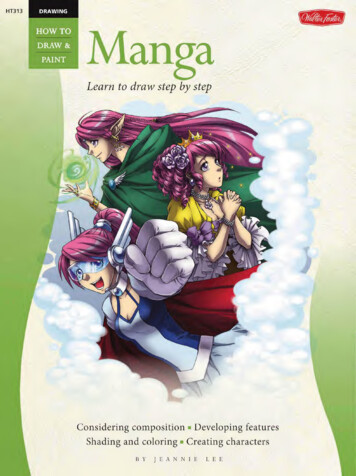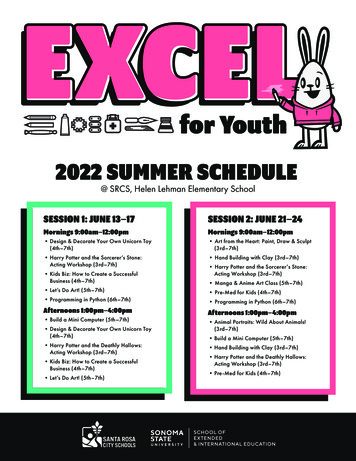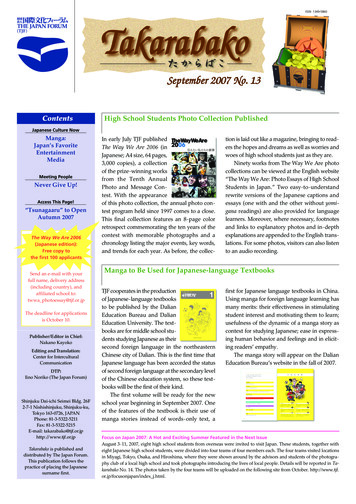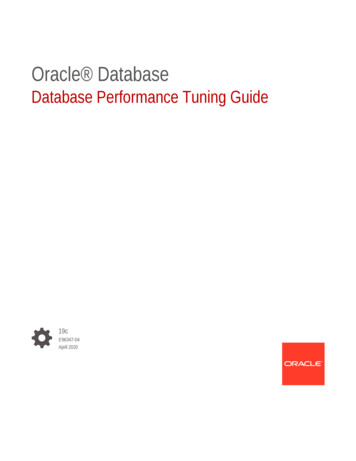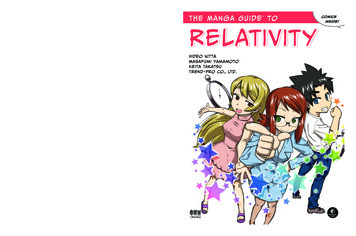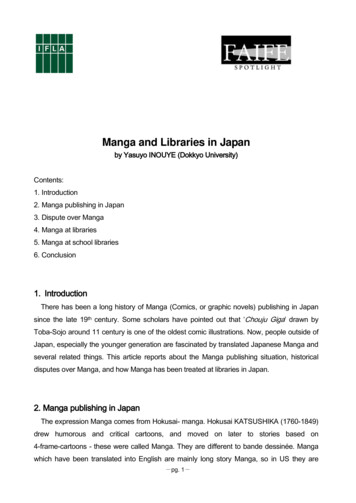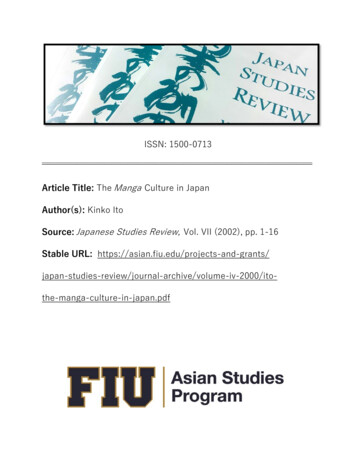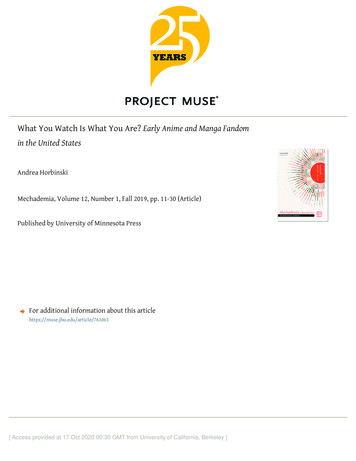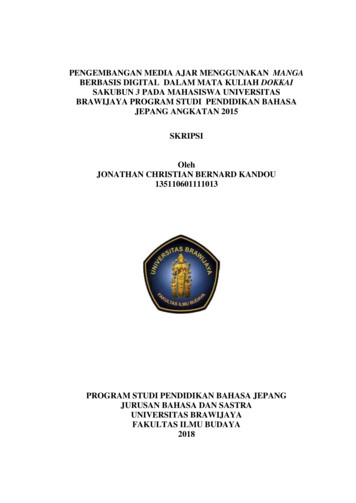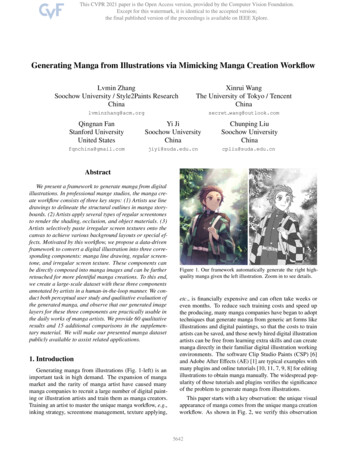
Transcription
Generating Manga from Illustrations via Mimicking Manga Creation WorkflowLvmin ZhangSoochow University / Style2Paints ResearchChinaXinrui WangThe University of Tokyo / TencentChinalvminzhang@acm.orgsecret wang@outlook.comQingnan FanStanford UniversityUnited StatesYi JiSoochow UniversityChinaChunping LiuSoochow pliu@suda.edu.cnAbstractWe present a framework to generate manga from digitalillustrations. In professional mange studios, the manga create workflow consists of three key steps: (1) Artists use linedrawings to delineate the structural outlines in manga storyboards. (2) Artists apply several types of regular screentonesto render the shading, occlusion, and object materials. (3)Artists selectively paste irregular screen textures onto thecanvas to achieve various background layouts or special effects. Motivated by this workflow, we propose a data-drivenframework to convert a digital illustration into three corresponding components: manga line drawing, regular screentone, and irregular screen texture. These components canbe directly composed into manga images and can be furtherretouched for more plentiful manga creations. To this end,we create a large-scale dataset with these three componentsannotated by artists in a human-in-the-loop manner. We conduct both perceptual user study and qualitative evaluation ofthe generated manga, and observe that our generated imagelayers for these three components are practically usable inthe daily works of manga artists. We provide 60 qualitativeresults and 15 additional comparisons in the supplementary material. We will make our presented manga datasetpublicly available to assist related applications.1. IntroductionGenerating manga from illustrations (Fig. 1-left) is animportant task in high demand. The expansion of mangamarket and the rarity of manga artist have caused manymanga companies to recruit a large number of digital painting or illustration artists and train them as manga creators.Training an artist to master the unique manga workflow, e.g.,inking strategy, screentone management, texture applying,Figure 1. Our framework automatically generate the right highquality manga given the left illustration. Zoom in to see details.etc., is financially expensive and can often take weeks oreven months. To reduce such training costs and speed upthe producing, many manga companies have began to adopttechniques that generate manga from generic art forms likeillustrations and digital paintings, so that the costs to trainartists can be saved, and those newly hired digital illustrationartists can be free from learning extra skills and can createmanga directly in their familiar digital illustration workingenvironments. The software Clip Studio Paints (CSP) [6]and Adobe After Effects (AE) [1] are typical examples withmany plugins and online tutorials [10, 11, 7, 9, 8] for editingillustrations to obtain manga manually. The widespread popularity of those tutorials and plugins verifies the significanceof the problem to generate manga from illustrations.This paper starts with a key observation: the unique visualappearance of manga comes from the unique manga creationworkflow. As shown in Fig. 2, we verify this observation5642
Figure 2. Justification for our motivation: the classic professional manga creation workflow. Artists first ink structural line drawings, andthen apply regular screentones and irregular screen texture to obtain the final manga.by studying the manga creation workflow in professionalstudios. Firstly, artists draw line drawings as the initialoutlines in manga storyboards, e.g., the artist delineates theline structure of the girl portrait in Fig. 2-(a). Secondly,artists paste screentone sheets with different regular patternsonto the regions between lines, e.g., the hair, eyes and dressin Fig. 2-(b) are pasted with such screentone sheets. Thirdly,artists fill the canvas with irregular screen textures to achievebackground layouts or special effects, e.g., the artist appliesthe romantic background screen texture to set off the moodof the girl character in Fig. 2-(c). We can see that thesethree steps are sufficient and necessary to determine theappearance of a manga image, and each step is indispensablefor preparing the high-quality manga product.Might we be able to achieve a program that can mimicthe above workflow, producing manga images with similar appearance to the ones created by artists manually withthis workflow, and at the same time, yielding independentlyusable result layers that can assist artists in each step ofthis workflow? To achieve these goals, we present a deeplearning approach to mimic the manga creation workflowstep-by-step. Firstly, given an input illustration, our framework estimates a line drawing map that plays a similar roleto the line drawings inked by artists manually. Secondly, ourframework segments the input image into a fixed number ofscreentone classes, and pastes corresponding regular screentone sheets onto the image regions of each class. Thirdly, ourframework predicts a texture mask to identify the areas thatneed to be pasted with screen textures, and afterwards synthesizes irregular textures in the identified areas. In this way,our framework automatically produces the line drawings,regular screentones, and screen textures. Those componentscan be independently used by artists for further creation, orcan be directly composed into the manga outputs.To this end, we invite artists to annotate a large-scaledataset and learn a hierarchical neural network in a datadriven manner. Our dataset contains 1502 image&annotationpairs of {illustration image, line drawing annotation, regularscreentone segmentation annotation, and irregular screen texture mask annotation}. All annotations are achieved with ahuman-in-the-loop approach, and checked by multiple artistsfor quality assurance. We will make this dataset publiclyavailable to assist related applications.Experiments show that mimicking the manga creationworkflow yields several advantages. Firstly, in qualitativeanalyse, our framework can produce not only single mangaimage but also independent image layers at each workflowstep to assist artists. Then, in perceptual user study, ourframework tends to learn the artist decisions recorded inour presented dataset for each workflow step, making ourframework preferred by the artists, as the manga creationdepends heavily on content semantics and even artist perception. Furthermore, we provide 60 qualitative results and 15additional comparisons in the supplementary material.In summary, our contributions are: (1) We propose adata-driven framework to generate manga from illustrationsby mimicking the professional manga creation workflow,including the steps of line drawing inking, regular screentonepasting, and irregular screen texture pasting. (2) We present alarge-scale artistic dataset of illustration and annotation pairsto facilitate the problem to generate manga from illustrationsand assist related applications. (3) Perceptual user study andqualitative evaluations demonstrate that our framework ismore preferable by artists when compared to other possiblealternatives.2. Related WorkScreentone and manga processing. The synthesis ofmanga screentone or halftoned texture is a unique problem with considerable demand. Halftoning exploits thespatial integration of human vision to approximate the intensity over a small local region with black-and-white pixels [24, 16, 44, 21]. Path-based methods [45, 32] try toreduce the artifact patterns by adjusting the scanning pathover images. Knuth et al. [24] enhance edges in a prepro-5643
Figure 3. Overview of our framework. Given an input illustration, our framework separately estimates the line drawing, regular screentonesegmentation, and the irregular screen texture mask. These components are composed to produce the final manga result. All convolutionallayers use 3 3px kernels and are processed by Batch Normalizations (BNs) and ReLU activations.cessing step to preserve the edges. Afterwards, Buchanan etal. [3] preserve the fine structure by optimising the structuresimilarity. Perception-aware methods [51, 52, 34, 36] mappixel-wise or region-wise luminance to screentone patternsto achieve perceptually distinguishable salient screentonestructure. Learning-based method Li et al. [26] train neuralnetworks to predict the sketching texture in an end-to-endmanner. Variational-auto-encoder screentone filler [53] mapsthe screened manga to an intermediate domain. Hatchingis another technique to halftoned effects. Winkenbach etal. [50] synthesise pen-and-ink illustrations by rendering ageometric scene with prioritised stroke textures. Our framework not only focuses on the synthesis of screentones, butalso works with the practical workflow of manga creation,including the steps of line drawing inking, screentone synthesis, and texture blending.Cartoon and digital painting techniques. Cartoon imageprocessing and computational digital painting have beenextensively studied in the past few decades. Manga structure extraction [25], cartoon inking [40, 38, 39], and lineclosure [29, 31] methods analysis the lines in cartoon anddigital paintings. A region-based composition method canbe used in cartoon image animating [41]. Stylization methods [5, 48, 54, 56, 55] generate cartoon images or artisticdrawings from photographs or human portraits. Line drawing colour filling applications [58, 43, 42] colourize sketch orline drawings with optimization-based or learning-based approaches. Our approach generates manga from illustrationsand digital paintings, and can be used in manga products andrelated cartoon or digital painting applications.Image-to-image translation and stylization. The task ofgenerating manga from illustrations can also be seen as animage-to-image translation or image stylization problem.For example, paired image-to-image translation [20, 47, 4]and unpaired methods [59, 22, 2, 57, 14, 30]. These methods can transform images across categories, e.g., mapsto-aerials, edges-to-cats, and in our case, illustrations-tomanga. Neural style transfer [17, 19, 27] can stylize imagesvia transferring low-level style features to the content images. Our experiments include typical candidates of thesemethods, analysing the differences between our customizedframework and these generic methods.3. MethodWe present an overview of our framework as shown inFig. 3, where the input is an illustration X Rw h c(Fig. 3-left), whereas the output is a manga image Y Rw h (Fig. 3-right), with w, h, c being the image width,height, and channel quantity. We train Convolutional NeuralNetworks (CNNs) to mimic the professional manga creationworkflow with the following three steps:Firstly, to mimic the behaviour that artists ink line drawings to delineate the structural outlines in manga storyboards(Fig. 2-(a)), our framework estimates a line drawing mapL̂ Rw h (Fig. 3-(a)). Learnt from thousands of images, our neural network inks salient structural lines andsuppresses unwanted constituents like noises and shadowinterferences.Secondly, to mimic the behaviour that artists paste regularscreentones to depict the manga shading and object materials(Fig. 2-(b)), our framework estimates a panoptic segmentation map, namely the regular screentone segmentation mapŜ Rw h N (Fig. 3-(b)), with N representing the numberof screentone classes. Such segmentation yields a set of region labels, and each label indicates one type of screentonethat should be pasted to each region. Our framework then5644
pastes the screentones according to such region-wise labels.Thirdly, to mimic the behaviour that artists paste irregularscreen textures to achieve background layouts or specialeffects (Fig. 2-(c)), our framework estimates an irregulartexture mask M̂ Rw h (Fig. 3-(c)) to identify the areasthat should be covered with irregular textures, and afterwardssynthesizes manga textures for those identified areas.Finally, the output manga image Y can be composed withY L̂ ϕtone (Ŝ) ϕtex (M̂ , X) ,(1)where is Hadamard product, ϕtone (·) is a tone transform(described in § 3.2) that pastes screentone sheets accordingto the given screentone segmentation Ŝ, and ϕtex (·, ·) isa texture transform (described in § 3.3) that synthesizestextures given the texture mask M̂ and the illustration X.In order to train this framework, we invite artists to annotate a dataset containing 1502 pairs of {illustration X, linedrawing map L, regular screentone segmentation map S,and irregular texture mask M }. These data are annotated ina human-in-the-loop manner, i.e., artists create annotationsfor our framework to learn, and our framework estimatescoarse annotations for artists to refine. The annotating approach is detailed in § 4.3.1. Inking line drawingWhen creating manga in real life, artists ink line drawingsto outline the object structures in manga storyboards. Ourframework estimates a line drawing map L̂ to mimic thisartist behaviour. Given the ground truth line drawing L andthe estimation L̂, we customize a likelihood Link with X Link L̂p Lp 22 λi φ(L̂)p φ(L)p 22 , (2)pwhere p is pixel position, · 2 is Euclidean distance, and λiis a weighting parameter. The operator φ(·) is a high-passtransform that penalizes the line patterns — we observe thatthe line patterns in line drawings routinely come with sparseand discrete high-amplitude/frequency transitions over pixelintensities, and we tailor-make the transform φ(·) to identifysuch line patterns that are “darker” than their surroundinglow-frequency domain with( L̂p g(L̂)p 2 , if L̂p g(L̂)p ;φ(L̂)p (3)0,others,Figure 4. Pasting regular screentone. (a) Examples of real-lifescreentone sheets. (b) Standard manga screentone classes and corresponding label colours. (c) Example illustration. (d) Screentonesegmentation map annotated by artists manually. (e) Screentonespasted according to the segmentation.and object materials. A widely-used commercial screentonestandard “JAPAN-DELETER-SE” [13] (Fig. 4-(a)) includes8 types of manga screentone sheets (Fig. 4-(b)). Based onthis standard, our framework estimates a screentone segmentation map Ŝ (Fig. 4-(d)) with 8 classes corresponding tothese 8 types of screentones. With the estimated logits Ŝ andthe ground truth label S, we measure the likelihood Lsegwith the Softmax Cross Entropy [49] asXLseg log(ψ(Ŝp ) Sp )i ,(4)p,iwhere ψ(·) is Softmax [49] operation, p is pixel position, andi is class channel index. We further observe how artists pastescreentone sheets, and find that artists are accustomed topaste screentones in a region-wise manner instead of in pixelwise, i.e., artists paste screentone sheets region-by-regionrather than pasting independent sheets for each individualpixel. To achieve such region-wise consistency, we usethe Felzenszwalb [15] super-pixel algorithm to segment theinput image X into a set of over-segmented regions Ω {ω1.n }, and penalize the region-wise variation Lvar withwhere g(·) is a Gaussian filter with a sigma of 3.0. With thistransform, the likelihood Link not only describes how closethe estimation L̂ is to the ground truth L, but also penalizesthe lines guided by the transform φ(·).3.2. Pasting regular screentoneManga artists paste screentone sheets with regular patterns onto their canvases to render the shading, occlusion,Lvar X Ŝp Ŝω(p) 22 ,(5)pwhere ω(p) is a super-pixel region in Ω that the pixel pbelongs to, and Ŝω(p) is the average value of Ŝ in the region ω(p). By encouraging the region-wise consistency,this penalty mimics the artist behaviour of region-by-region5645
where o(p) is a 3 3 window centred at the pixel position p, with δ(·) being an anisotropic term δ(X)ij exp( Xi Xj 22 /κ2 ), and κ is an anisotropic weight.The term δ(X)ij increases when o(p) is located at consecutive and monotonic areas with uniform pixel intensities,and decreases when o(p) comes across salient contours likeedges. Afterwards, given the estimated mask M̂ , our framework synthesizes manga textures in the masked areas with atexture transform ϕtex (·, ·) asXϕtex (M̂ , X)p ξ(X)p M̂p ,(9)pFigure 5. Pasting irregular screen texture. (a) Example illustration.(b) Screen texture mask annotated by artist manually. (c-h) Different types of halftone transforms. The “*” indicates the defaulttransform used by our framework.where ξ(·) is a halftone transform to synthesize texture. Ourframework allows the transform ξ(·) to be chosen from manypopular halftone synthesizing algorithms [24, 16, 44, 21,45, 32] as shown in Fig. 5-(c-h), and we use the dottedtransform [44] (Fig. 5-(h)) by default.3.4. Neural architecture and learning objectivescreentone sheet pasting. Afterwards, our framework pastesthe screentones according to the segmentation Ŝ with a tonetransform ϕtone (·) asϕtone (Ŝ)p Xψ(Ŝp )i (Ti )p ,(6)iwhere Ti Rw h is a screentone image computed by tilingthe i-th screentone patch in Fig. 4-(b). We show an example of the transform ϕtone (·) in Fig. 4-(e), where thescreentone segmentation (Fig. 4-(d)) is transformed usingthe screentone-label correspondence in Fig. 4-(b).3.3. Pasting irregular screen textureThe screen texture pasting is an indispensable step in themanga creation workflow. Such screen textures have irregular patterns and can be used in scenarios like backgroundlayouts or special effects. Our framework identifies the areasthat need to be pasted with screen texture by estimating atexture mask M̂ (Fig. 5-(b)). We minimize the likelihoodLmask between the estimation M̂ and the ground truth MwithXLmask M̂p Mp 22 ,(7)pwhere p is pixel position. Furthermore, we observe howartists paste screen textures, and find that artists tend to pasteidentical texture in consecutive and monotonic areas, e.g.,large backgrounds, full-screen effects, big fonts, etc. Toachieve the spacial coherency in such areas, we introduce ananisotropic penalty Lani with X X X Lani δ(X)ij M̂i M̂j 22 , (8)p i o(p) j o(p)Our neural network architecture consists of three convolutional decoders: inking decoder, segment decoder, andmask decoder (Fig. 3). We apply Batch Normalization [18]and ReLU activation [33] to each convolutional layer. Thesampling layers have skip connections in U-net [37] style.The three decoders are trained jointly with the loss term LwithL λ1 Link λ2 Lseg λ3 Lmask λvar Lvar λani Lani , (10)where λ1.3 , λvar , λani are weighting parameters. Giventhat the architecture is fully convolutional, this model isapplicable to images with adjustable resolutions.4. DatasetOur dataset contains 1502 pairs of {illustration X, linedrawing map L, regular screentone segmentation map S,and irregular texture mask M } in 1024px resolution. Weprovide examples in the supplemental material. We invite5 artists to annotate the dataset. The data preparation startswith a relatively small set of 56 illustration and line drawingpairs collected by searching the key word “illustration withline drawing” in Pixiv [35]. Artists align and retouch those56 line drawings into usable annotations. Next, artists manually create 56 paired screentone segmentation maps using acommercial segmentation annotation tool [28] and 56 texturemasks using Adobe Photoshop “quick select” tool. We trainour framework on these initial data for 20 epochs and estimate coarse annotations for 1446 high-quality illustrations inDanbooru [12]. Artists refine those coarse estimations into final annotations. We view 100 refinements as one loop. Wheneach loop is finished, we train our framework on the newdata for 50 epochs and all old-and-new data for 20 epochs,and then re-estimate coarse annotations for the remaining5646
Inputillustration XLine drawingL̂Screentonesegmentation ŜScreentoneϕtone (Ŝ)Screen texturemask M̂Screen textureϕtex (M̂ , X)Outputmanga YFigure 6. Qualitative results. We show the generated manga image layers. 60 additional results are available in the supplementary material.MethodLi 2019 [26]Qu 2008 [36]CSP 2020 [6]Xie 2020 [53]AHR 3.11 0.534.66 0.312.66 0.374.11 0.29Ours1.33 0.24Table 1. Average Human Ranking (AHR) of the manga imagesgenerated by different methods. The arrow ( ) indicates that loweris better. Top 1 (or 2) score is marked in blue (or red).MethodAMTFR Li 2019 [26]Qu 2008 [36]CSP 2020 [6]Xie 2020 [53]9.52%1.16%11.52%5.06%Ours24.54%Table 2. Amazon Mechanical Turk Fooling Rate (AMTFR) ongenerated manga images. This metric reflects how indistinguishablethe generated manga images are from real ones. Top 1 (or 2) scoreis marked in blue (or red). Higher ( ) is better.unrefined illustrations. In parallel, all 5 artists are invited tocheck the annotation quality in that loop. Artists are allowedto remove any annotations when they find low-quality ones.This human-in-the-loop annotation workflow finishes whenthe quality of each annotation has been assured by at leastthree artists.5. Evaluation5.1. Experimental settingCompared approaches. We test several typical mangageneration methods of (1) the traditional optimization-basedmanga screentone method Qu et al. 2008 [36], (2) the com-mercial manga software CSP 2020 [6], (3) the learning-basedstylization framework Li et al. 2019 [26], (4) the state-ofthe-art manga effect ScreenVAE from Xie et al. 2020 [53],(5) Pix2Pix [20], and (6) our framework.Implementation details. Our framework is trained usingthe Adam optimizer [23] with a learning rate of lr 105 ,β 0.5, a batch size of 16, and 100 epochs. Trainingsamples are randomly cropped to be 224 224 pixels andaugmented with random left-and-right flipping. Besides,Qu [36] supports arbitrary screentone types, and we set it touse the same screentones with us. CSP [6] supports a vastmajority of screentones with commercial standards, and wechoose the same screentones as ours in the their interface.Li [26], Xie [53], and Pix2Pix [20] are learning-based methods with official implementations, and we train them on theillustration-to-manga pairs composed with our dataset.Hyper-parameters. We use the default (and recommended) configuration of our framework: λi 0.5, κ 0.1, λ1 1.0, λ2 1.0, λ3 1.0, λvar 0.1, andλani 0.1.Testing samples. The tested images are Pixiv [35] andDanbooru [12] illustrations sampled randomly in differentexperiments. We make sure that all tested images are unseenfrom the training dataset.5.2. Perceptual user studyThe user study involves 15 individuals, where 10 individuals are non-artist students, and the other 5 are professional5647
IllustrationGreyscaleCSP 2020 [6]Qu 2008 [36]Pix2Pix [20]Li 2019 [26]Xie 2020 [53]OursFigure 7. Comparisons to possible alternative methods. 15 additional full-resolution comparisons are available in the supplementary material.artists. Each artist has at least three months of manga creation experience. We randomly sample 150 unseen illustrations in Danbooru [12], and then use the involved 5 methods([53, 36, 26, 6] and ours) to generate 150 result groups, witheach group containing 5 results from 5 methods. The participants are invited to rank the results in each group. Whenranking the results in each group, we ask users the question– “Which of the following results do you prefer most to usein commercial manga? Please rank the following imagesaccording to your preference”. We use the Average HumanRanking (AHR) as the testing metric. For each group inthe 150 groups, one random user ranks the 5 results in thecurrent group from 1 to 5 (lower is better). Afterwards, wecalculate the average ranking obtained by each method.The results of this user study is reported in Table 1. Wehave several interesting discoveries: (1) Our framework outperforms the secondly best method by a large margin of1.33/5. (2) The commercial software CSP 2020 [6]reportsthe secondly best score. (3) The two learning-based methods[26, 53] reports similar perceptual quality, with [53] slightlybetter than [26]. (4) Qu 2008 [36] reports a relatively lowuser preference, possibly due to its hard threshold whensegmenting screentone regions.We also conduct a user study with the Amazon Mechanical Turk Fooling Rate (AMTFR). The turk workers firstwatch a few real manga on the VIZ-manga [46] website,and then play with all the tested tools for 15 minutes to getfamiliar with the appearance of the “real/fake” manga. Werandomly shuffle the 150 fake manga images (generated bythe 5 tested methods as described in § 5.2) and another 150images cropped from the real VIZ manga. We afterwards askthe turk workers to tell whether each image is real manga.The workers’ mistake rate (fooling rate) reflects how thegenerated manga is indistinguishable from the real mangaproducts. The result is presented in Table 2. We can seethat our framework reports the highest fooling rate, morethan twice that of the secondly best method. This is becauseour framework mimics the real manga creation workflow tosimulate the manga created by artists manually.5.3. Qualitative resultWe present decomposed qualitative results in Fig. 6 and60 additional results in the supplementary material. We cansee that our framework not only generates satisfactory mangaresults, but also produces independent image layers of linedrawing, screentone, and screen texture. These layers are5648
(a) Illustration(b) W/o inking(c) W/o segment(d) W/o masking(e) W/o φ(·)(f) W/o Lvar(g) W/o Lani(h) OursFigure 8. Ablative study. We study the impact of each individual component within our framework by removing components one-by-one.practically usable in the daily works of manga artists.5.4. Visual comparisonWe present comparisons with previous methods [26, 36,6, 53, 20] in Fig. 7 and 15 additional comparisons in thesupplementary material. We also provide greyscale imagesfor reference. We can see that CSP 2020 [6] and Qu etal. 2008 [36] can only map region-wise or pixel-wise intensity to screentone dots. Li et al. 2019 [26] causes boundary/detail distortion, e.g., the girl eyes. Xie et al. 2020 [53]and Pix2Pix [20] suffer from severe blurring/halo artifacts(when zooming in), e.g., the cake decoration. Our frameworkmimics the artist workflow and yields sharp and clean mangaproducts.5.5. Ablative studyAs shown in Fig. 8, the ablative study includes the following experiments. (1) We remove the inking decoder andtrain our framework without line drawing maps. We cansee that the removal of line drawing fails our framework inoutlining the object structure (Fig. 8-(b)). (2) If trained without the screentone segmentations (with the segment decoderremoved), the framework cannot mimics the artist behaviourof region-by-region screentone pasting, yielding screentonedistortions (Fig. 8-(c)). (3) If trained without the screen texture masks (with the mask decoder removed), the frameworkfails to capture appropriate textures, resulting in dull anddefective tone transitions (Fig. 8-(d)). (4) If trained without the line pattern penalty φ(·), the lines become blurred(Fig. 8-(e)). (5) If trained without the region-wise variationpenalty Lvar , the framework suffer from screentone type inconsistency (Fig. 8-(f)). (6) If trained without the anisotropicpenalty Lani , the textured areas become uncontrolled andnoisy (Fig. 8-(g)). (7) The full framework suppresses thesetypes of artifacts and achieves a satisfactory balance over theline drawing, screentone, and screen texture (Fig. 8-(h)).5.6. Influence of hyper-parametersA weak region-wise variation penalty (Lvar 0.01)causes inconsistency tone over adjacent regions, whereasa too strong penalty (Lvar 1.0) causes texture vanishing.Besides, a weak anisotropic penalty (Lani 0.01) causestextural distortion, whereas a too strong penalty (Lani 1.0)causes low contrast in detailed constituents. See also thesupplement for examples.6. ConclusionWe present a framework to generate manga from illustrations by mimicking the manga creation workflow, includingthe steps of line drawing inking, regular screentone pasting,and irregular screen texture pasting. We invite artists to annotate a large-scale dataset to train the neural networks, andthe dataset will be publicly available. Both quantitative andqualitative experiments elaborate that the users prefer ourlayered manga products compared to possible alternatives.7. AcknowledgementThis technique is presented by Style2Paints Research.This work is supported by National Natural Science Foundation of China Nos 61972059, 61773272, 61602332; NaturalScience Foundation of the Jiangsu Higher Education Institutions of China No 19KJA230001, Key Laboratory ofSymbolic Computation and Knowledge Engineering of Ministry of Education, Jilin University No93K172016K08; thePriority Academic Program Development of Jiangsu HigherEducation Institutions (PAPD). We thank Qianwen Lu for thehelpful discussions for the technical merits and limitations.5649
References[1] Adobe. Adobe after effects. Adobe, 2020.[2] Konstantinos Bousmalis, Nathan Silberman, David Dohan,Dumitru Erhan, and Dilip Krishnan. Unsupervised pixellevel domain adaptation with generative adversarial networks.CVPR, 2017.[3] J. W. BUCHANAN, , VEREVKA, and O. Edge preservation with space-filling curve half-toning. In Proceedings ofGraphics Interface 95, 7582. ACM, 1995.[4] Qifeng Chen and Vladlen Koltun. Photographic image synthesis with cascaded refinement networks. In ICCV, 2017.[5] Yang Chen, Yu-Kun Lai, and Yong-Jin Liu. CartoonGAN:Generative adversarial networks for photo cartoonization. In2018 IEEE/CVF Conference on Computer Vision and PatternRecognition. IEEE, jun 2018.[6] clip studio. Clip studio paints. clip studio, 2020.[7] clip studio. The complete clip studio paint screentone tutorial. tonetutorial/, 2020.[8] clip studio.Csp: Turning your art into /04/18/cspturning-your-art-into-screentone/, 2020.[9] clip studio. Making comic backgrounds using layer p
Generating manga from illustrations (Fig. 1-left) is an important task in high demand. The expansion of manga market and the rarity of manga artist have caused many manga companies to recruit a large number of digital paint-ing or illustration artists and train them as manga creators. Training an artist to master the unique manga workflow, e.g.,
